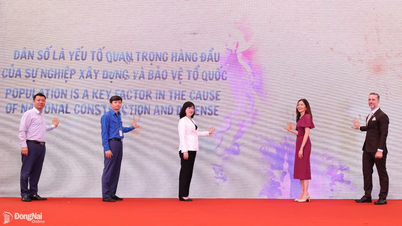Doctors monitor the health of mothers and children at the Department of Obstetrics and Gynecology , Lam Dong II Hospital
The Ministry of Health has directed the Departments of Health of provinces and centrally run cities to implement the Population Communication Plan for 2025; including organizing activities in response to World Population Day (July 11). The Ministry of Health will coordinate with the United Nations Population Fund Office in Vietnam to organize a rally on July 11, 2025 in Hanoi.
According to the announcement of the United Nations Population Fund Office in Vietnam, the theme of World Population Day on July 11, 2025 is Reproductive autonomy in a changing world.
The Department of Population requests the Department of Health of provinces and centrally-run cities to pay attention to and direct the Department of Population/Population - Family Planning/Population Division under the Department of Health and relevant agencies and units to proactively advise, develop plans and implement activities, ensuring effectiveness, in accordance with the actual situation of population work in the locality and report the implementation results to the Department of Population before July 30, 2025.
Last June, the National Assembly Standing Committee passed the Ordinance Amending and Supplementing Article 10 of the Ordinance on Population. Specifically, the rights and obligations of each couple and individual in implementing family planning and reproductive health care: Decide on the time of giving birth, the number of children and the interval between births in accordance with the age, health status, conditions of study, work, work, income and child-rearing of the couple and individual on the basis of equality. Protect health, implement measures to prevent reproductive tract infections, sexually transmitted diseases, HIV/AIDS and implement other measures related to reproductive health care. This Ordinance takes effect from June 3, 2025.
According to published data sources, the total fertility rate (TFR) in 2024 of 34 provinces and centrally-run cities after the arrangement has changed in terms of replacement fertility. From 21 provinces and cities with fertility below replacement level (TFR below 2.1 children/woman), now only 13/34 localities fall into this group.
The five provinces with the lowest fertility rates in the country are Ho Chi Minh City (1.43 children/woman), Tay Ninh (1.52), Can Tho (1.55), Ca Mau (1.58) and Vinh Long (1.60). On the contrary, the three provinces with the highest fertility rates are Dien Bien (2.65), Tuyen Quang (2.55) and Lao Cai (2.5). 18 provinces have fertility rates ranging from replacement level to below high level (TFR from 2.1 to below 2.5).
After the merger, provinces with low birth rates will continue to be encouraged and supported to maintain replacement fertility and avoid premature population aging.
In order to encourage births in localities with low birth rates, many support policies have been implemented. Previously, Ho Chi Minh City had made a list of support for women who give birth to 2 children before the age of 35 with a cost of 3 million VND.
Pregnant women and newborns from poor, near-poor households, social protection households or living in island communes will be supported with prenatal and newborn screening with a total amount of 2 million VND, including 600,000 VND for prenatal screening, 400,000 VND for newborn screening and 1 million VND in direct support.
According to the Department of Population (Ministry of Health), after merging provinces and cities, some localities recorded changes in birth rates - an important indicator in the Population Strategy to 2030 and having a great impact on socio-economic development.
Source: https://baolamdong.vn/quyen-tu-quyet-ve-sinh-san-trong-mot-the-gioi-dang-thay-doi-381983.html






![[Photo] General Secretary attends the parade to celebrate the 80th anniversary of the founding of the Korean Workers' Party](https://vphoto.vietnam.vn/thumb/1200x675/vietnam/resource/IMAGE/2025/10/11/1760150039564_vna-potal-tong-bi-thu-du-le-duyet-binh-ky-niem-80-nam-thanh-lap-dang-lao-dong-trieu-tien-8331994-jpg.webp)
![[Photo] Opening of the World Cultural Festival in Hanoi](https://vphoto.vietnam.vn/thumb/1200x675/vietnam/resource/IMAGE/2025/10/10/1760113426728_ndo_br_lehoi-khaimac-jpg.webp)
![[Photo] Discover unique experiences at the first World Cultural Festival](https://vphoto.vietnam.vn/thumb/1200x675/vietnam/resource/IMAGE/2025/10/11/1760198064937_le-hoi-van-hoa-4199-3623-jpg.webp)





























![[Photo] Ho Chi Minh City is brilliant with flags and flowers on the eve of the 1st Party Congress, term 2025-2030](https://vphoto.vietnam.vn/thumb/1200x675/vietnam/resource/IMAGE/2025/10/10/1760102923219_ndo_br_thiet-ke-chua-co-ten-43-png.webp)

































































Comment (0)